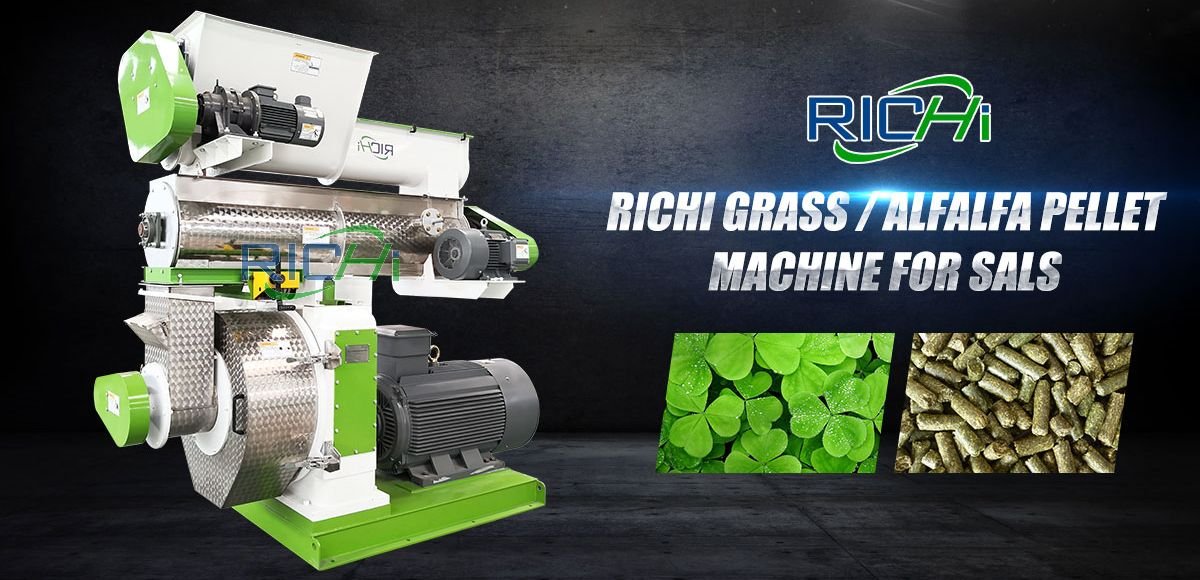ay pellet machines are versatile equipment used to convert various types of hay and forage materials into compact, easy-to-handle pellets. The choice of materials for use in these machines is crucial for producing high-quality pellets and ensuring efficient operation. This article explores the most suitable materials for hay pellet machines, considering factors such as nutritional value, pelletizing properties, and machine compatibility.
- Alfalfa (Lucerne)
Alfalfa is widely considered one of the best materials for hay pellet machines:
- High Nutritional Value: Rich in protein, fiber, and essential minerals.
- Excellent Binding Properties: Natural lignin content aids in pellet formation.
- Versatility: Suitable for various livestock, including cattle, horses, and rabbits.
- Pelletizing Efficiency: Forms dense, durable pellets with minimal additives.
Alfalfa’s combination of nutritional benefits and pelletizing characteristics makes it a top choice for hay pellet production.
Related post:Grass Pellet Machine
- Timothy Grass
Timothy grass is another excellent option for hay pellet machines:
- Low Protein, High Fiber: Ideal for animals requiring a high-fiber diet.
- Good Pelletizing Properties: Forms stable pellets with proper moisture content.
- Palatability: Highly appealing to many herbivores, especially horses.
- Dust Reduction: Pelletized timothy reduces respiratory issues associated with loose hay.
Timothy pellets are particularly popular in the equine industry due to their nutritional profile and palatability.
- Orchard Grass
Orchard grass is well-suited for hay pellet machines:
- Balanced Nutrition: Offers a good mix of protein and fiber.
- Excellent Taste: Highly palatable for most livestock.
- Good Pellet Integrity: Forms stable pellets when properly processed.
- Versatility: Suitable for various ruminants and small animals.
Orchard grass pellets are often used in mixed feed formulations due to their balanced nutritional profile.
- Bermuda Grass
Bermuda grass is a popular choice in warmer climates:
- Heat Tolerance: Maintains nutritional value in hot conditions.
- Good Fiber Content: Suitable for maintaining digestive health in livestock.
- Pelletizing Efficiency: Forms consistent pellets with proper moisture management.
- Cost-Effective: Often more economical than some other hay varieties.
Bermuda grass pellets are particularly common in regions where this grass thrives naturally.
- Oat Hay
Oat hay is an excellent material for hay pellet machines:
- High Energy Content: Provides good caloric value for livestock.
- Balanced Nutrition: Offers a mix of fiber, protein, and minerals.
- Good Pellet Formation: Forms stable pellets with proper processing.
- Digestibility: Easily digestible for various animals, including horses and cattle.
Oat hay pellets are often used as a supplementary feed due to their energy content and digestibility.
- Mixed Grass Hay
Combining different grass types can yield excellent results in hay pellet machines:
- Nutritional Balance: Blending grasses can create an optimal nutritional profile.
- Improved Pellet Quality: Different grass types can complement each other in pellet formation.
- Flexibility: Allows for customization based on available materials and animal needs.
- Cost-Effectiveness: Can utilize locally available grass varieties.
Mixed grass hay pellets offer versatility and can be tailored to specific nutritional requirements.
- Straw (as a supplement)
While not typically used alone, straw can be an effective supplement in hay pellet production:
- Filler Material: Can be mixed with higher-quality hay to reduce costs.
- Fiber Boost: Increases fiber content in pellet formulations.
- Improved Pellet Density: Can enhance pellet formation when mixed with leafier materials.
- Economical Option: Often a cost-effective way to increase pellet volume.
Straw is typically used in small proportions to supplement other hay materials.Factors Influencing Material SuitabilitySeveral factors determine the suitability of materials for hay pellet machines:
- Moisture Content: Ideal moisture levels (typically 10-15%) are crucial for proper pellet formation.
- Fiber Length: Materials should be properly chopped to ensure uniform pellet formation.
- Nutritional Requirements: The choice of hay should align with the nutritional needs of the target animals.
- Pellet Durability: Materials should form pellets that can withstand handling and transportation.
- Machine Compatibility: Different hay pellet machines may have specific material requirements.
Preparation and Processing ConsiderationsTo ensure optimal results, materials used in hay pellet machines often require preparation:
- Drying: Ensuring proper moisture content through natural or artificial drying.
- Grinding: Reducing particle size for uniform pellet formation.
- Conditioning: Adding steam or water to improve binding properties.
- Mixing: Blending different materials or adding supplements for nutritional enhancement.
Conclusion
The choice of materials for hay pellet machines depends on various factors, including nutritional value, pelletizing properties, and the specific needs of the target animals. Alfalfa, timothy grass, orchard grass, Bermuda grass, oat hay, and mixed grass hays are among the most suitable materials, each offering unique benefits and characteristics.
When selecting materials for hay pellet production, it’s essential to consider the nutritional requirements of the animals, the pelletizing properties of the hay, and the specifications of the pellet machine. Proper preparation and processing of the chosen materials are crucial for producing high-quality, durable pellets.
As the demand for efficient animal feed solutions continues to grow, the importance of selecting the right materials for hay pellet machines becomes increasingly significant. By choosing appropriate materials and optimizing the pelletizing process, producers can create high-quality, nutritious feed pellets that meet the diverse needs of livestock and contribute to more efficient and sustainable agricultural practices.










